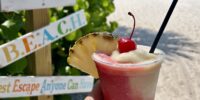Sanibel Songbirds Visit in Spring
Take the time while on vacation to keep an eye out for songbirds that are traveling as well! During migration, birds often become weak and need to stop for food. Be aware of your surroundings and spot some of the beautiful songbirds that drop by the island as a rest stop. Any action to help the conservation of these songbirds will help them get from one place to another. The smallest efforts can make the biggest impact.
Here are some Sanibel songbirds, all recently rehabilitated by CROW Clinic, to keep an eye out for while enjoying time on the beach or taking a walk with the family!
Bay-Breasted Warbler
Find the Bay-Breasted Warbler songbird hopping from tree to tree. These birds make their annual migration by joining with mixed-species groups to offer them more protection during their journey. Mature Bay-Breasted Warblers can be identified by their gray and red-brown coat. Immature birds of this species, like the one pictured, have a yellow-green head and neck. During the spring migration listen for the male’s song as they hop from bushes and trees, looking for food.
Fun Fact: The Bay-Breasted Warbler’s diet changes with the season. In the breeding season, they eat mostly insects and, in the non-breeding season, they eat mostly fruit.
Black and White Warbler
These medium-sized songbirds are unique with their slightly downcurved bill and flat heads. While their wings may be long, their necks and tail are very short. Find them in trees looking for insects while they creep up and down the branches. Be careful while walking through the woods or you might find yourself on top of this bird’s nest, often found at the base of trees.
Fun Fact: Black and White Warblers have an extra-long hind claw and heavier legs to help them hold onto and move around bark.
Blue Grosbeak
This beautiful songbird is unique because of their very large, triangular beak. The beak covers the entire face, from throat to forehead. Look for males by spotting their rich blue colors with a small black mask over the eyes. Their wings have specks of chestnut and their beak is a beautiful mix of black and silver. Females and immature males have a dusty copper color all over. Listen to these birds’ songs while they are perched at the top of shrubs and small trees.
Fun fact: The Blue Grosbeak raises two broods of nestlings each year.
Rose-Breasted Grosbeak
Rose-Breasted Grosbeaks are stocky songbirds with a large triangular bill. Adult males are black and white with a red chevron from the throat to the middle of the chest. Females are brown and have heavy streaks, with a white stripe over the eye. Both male and female birds have white patches in their wings and tails. Their large bills help these birds find food such as seeds, fruit and insects. Male Rose-breasted Grosbeaks sing a sweet, rambling song that is very distinctive. During migration, these birds make frequent stops at fruit trees to fuel their journey.
Fun Fact: The Rose-Breasted Grosbeak’s song is beloved by bird enthusiasts for its sweet sound, similar to a robin’s.
Cedar Waxwing
The Cedar Waxwing is a medium-sized bird with a sleek coat. Their unique coat is the easiest way to identify them. Waxwings are known for their pale brown head that fades to a soft grey and pale-yellow stomach, with a yellow tip on the tail. They are known to be social birds and travel in flocks. Find these birds flying from one fruit tree to another.
Fun Fact: Cedar Waxwings eat so much fruit that they can sometimes get a bit tipsy from digesting overripe berries.
Kentucky Warbler
Kentucky Warblers are small birds with an olive green coat and bright yellow underbelly. The male Kentucky Warbler is unique because they sing just one song throughout their life. Spot this bird by listening for its high-pitched song amongst the lower levels of the forest.
Fun Fact: Male warblers can match pitch with a competitor’s song.
Ovenbird
The Ovenbird has a rounded, squat body, round head, thick bill and a tail that can turn upward. These birds are an olive green on the top and have dark spots underneath. The white eyes give the Ovenbirds a surprised expression. Find these birds exploring the ground around groups of trees with a preppy stroll. Listen carefully on your mid-afternoon stroll with your family when the Ovenbird’s song is the loudest.
Fun Fact: The Ovenbird’s song sounds like it is saying ‘teacher’ over and over again.
Red-Eyed Vireo
Red-Eyed Vireos olive-green and white, with a grey, black and white pattern on their head. Red-eyed Vireos are unique due to their gray crown and white eyebrow stripe. Adults have red eyes that appear to be dark from far away. While these birds may be difficult to spot, they move slowly through the trees, searching for prey. The heat of the mid-afternoon draws out these birds, making them easier to spot.
Fun Fact: The songs of the Red-Eyed Vireo have been described as incessant. While each one is brief, males have been known to sing over 20,000 times a day!
Conservation Efforts on Sanibel Island
https://www.youtube.com/watch?v=eS6EWByVphs
The City of Sanibel, in partnership with the Sanibel-Captiva Conservation Foundation, “Ding” Darling Wildlife Society, and Sanibel-Captiva Audubon Society, invites you to view our NEW animated shorebird conservation video. This short, educational video highlights the threats Sanibel shorebirds face every day and showcases simple ways Sanibel residents and visitors can be good neighbors to shorebirds and other coastal wildlife.
The Clinic for the Rehabilitation of Wildlife is a teaching hospital and visitor education center dedicated to saving wildlife through state-of-the-art veterinary care, research, education and conservation medicine.
From Dr. Robin Bast, DVM, Staff Veterinarian at CROW
Traveling such long distances is a test of physical endurance, and there are many risks that these birds may encounter during migration. Often, this journey requires them to stop at certain land points to build up strength before traveling across large bodies of water to another continent. When weak from travel, these birds are more susceptible to being attacked by predators. Weather conditions such as tropical storms may blow birds off course, resulting in them being in an unfamiliar area often with limited access to their normal food sources.
Photos provided by CROW of Sanibel songbirds recently rehabilitated on Sanibel Island.















